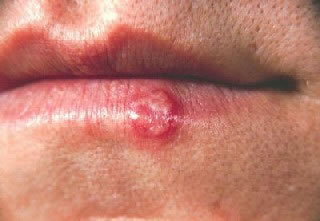Photos

Canker Sore on Lower Lip
This is a picture of a canker sore on the inner lip. These sores are painful. They can be caused by many things including: injury to the tissue in the mouth, citrus fruits, acidic vegetables and allergic reactions. Some diseases can also cause a canker sore to form.
Source: Wikimedia Commons
Permission is granted to copy, distribute and/or modify this document under the terms of the GNU Free Documentation License. This is a public domain image file from Wikimedia Commons. Wikimedia is a freely licensed media repository.

Cold Sore of Lower Lip
This shows a cold sore on the lip. Cold sores are caused by the Herpes simplex virus. This cold sore has been visible for two days.
Source: CDC PHIL
From the CDC's Public Health Image Library (http://phil.cdc.gov), ID#1573, in the public domain. Content Providers: CDC / Dr. Herman.